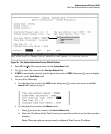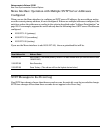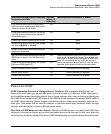
208
Enhancements in Release F.02.02
Operation and Enhancements for Multimedia Traffic Control (IGMP)
Operation and Enhancements for Multimedia Traffic
Control (IGMP)
How Data-Driven IGMP Operates
The information in this section supplements the information provided under "Multimedia Traffic
Control with IP Multicast (IGMP)" beginning on page 9-91 in the Management and Configuration
Guide included with your Series 2500 switch and also available at http://www.procurve.com.
This section uses the following terms to describe IGMP operation:
■ Querier: A required IGMP device that facilitates the IGMP protocol and traffic flow on a
given LAN. This device tracks which ports are connected to devices (IGMP clients) that
belong to specific multicast groups, and triggers updates of this information. With IGMP
enabled, the Series 2500 switches use data from the Querier to determine whether to forward
or block multicast traffic on specific ports. When the switch has an IP address on a given
VLAN, it automatically operates as a Querier for that VLAN if it does not detect a multicast
router or another switch functioning as a Querier.
■ IGMP Device: A switch or router running IGMP traffic control features.
■ IGMP Host: An end-node device running an IGMP (multipoint, or multicast communication)
application.
Without IGMP enabled, the switch simply floods all IP multicast traffic it receives on a given VLAN
through all ports on that VLAN (except the port on which it received the traffic). This can result in
significant and unnecessary bandwidth usage in networks where IP multicast traffic is a factor. Data-
Driven IGMP reduces this problem by authorizing the switch to restrict multicast traffic only to ports
where a given multicast group should flow.
Series 2500 switches (all software versions) use data-driven IGMP to better control IP multicast
traffic.
An IP multicast packet includes the multicast group (address) to which the packet belongs. When an
IGMP client connected to a switch port needs to receive multicast traffic from a specific group, it
joins the group by sending an IGMP report (join request) to the network. (The multicast group
specified in the join request is determined by the requesting application running on the IGMP client.)
When a networking device with IGMP enabled receives the join request for a specific group, it
forwards any IP multicast traffic it receives for that group through the port on which the join request
was received. To reduce unnecessary traffic, the networking device does not forward a given group’s


















